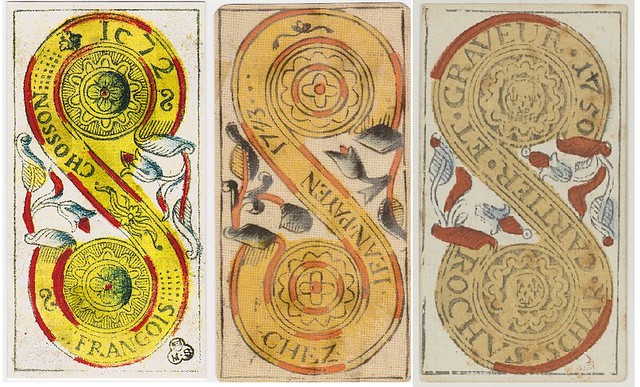Evil is in details as truth...
Hello Yves, hello Philippe!
Hello everybody!
I have to admit that the history of ancient Tarot decks is very intriguing, very fascinating.
So, here is another thought about the 1760 date.
Could it refer to the year in which the woodblocks were made?
In other words, Nicolas Conver used an old set of woodblocks to print his famous Tarot deck.
The story might have been something like this: one fine day, monsieur Conver came across an old set of woodblocks (either he purchased them in an antique shop or were gifted to him).
And he said: "WOW! These woodblocks are so cool. I'm gonna make a serie of Tarot decks with 'em, something very old-fashioned (à la ancienne)".
Of course these woodblocks presented signs of time-passage, usage and even woodworm marks. That would account for the angel's missing eye in the card of Temperance and other similar things.
Also, he got to have a name for these decks, something very potent and evocative.
So he decided to call them "the 1760 model", where in fact the date 1760 refers to the year in which the woodblocks were made and not when the cards were printed.
And that is how an old (and maybe forgotten) Tarot deck came to live once again.
LeRomain
Bonsoir Le Romain and all,
Here my version:
One Conver (most probably Mathieu father of Nicolas Conver) bought a set of woodblocks that have been effectively engraved in 1760.
He may have bought them before his own death (dated 1804) as to:
Either prepare tarot decks under his own name Mathieu Conver by erasing previous cardmaker name.
Or
Give this woodblocks to his son Nicolas Conver as to prepare his begining in cardmaking business.
(Nicolas CONVER was cardmaker from 1801 up to 1829).
So he may have replace previous cardmaker name by his son Family and given name (Nas = Nicolas + CONVER).
This name change may have been done just after Mathieu death (1804) by Nicolas Conver himself too.
To illustrate this here his my own picture I took from 2 of Deniers card woodblock in Museum in Marseille.
By looking carefully two zones you may see that:
1760 date is really part of woodblock.
Nas CONVER names are not really curved as per other lines of engraving.
A strange not engraved and empty zone is just after this Nas CONVER zone.
Probably previous cardmaker name was much longer that Nas CONVER.
Adding small part of engraved details was a normal practice in this times.
Regarding angel's missing eye in the card of Temperance just look at this very old card and see that this eye was clearly ok..... before worms start eating woodblock.
A XRay examination or other scanner technic would confirms (or not of course) this hypothesis.
Any views and or comments ?
Salutations from Marseille Tarot Laboratory

)
Yves





